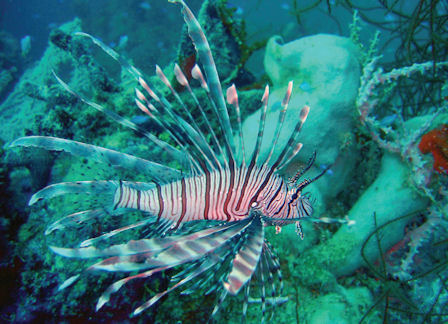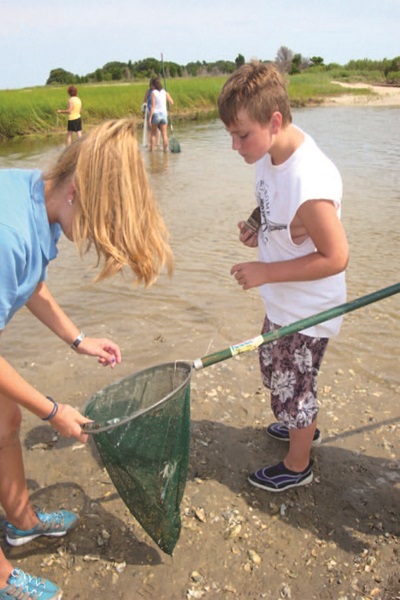SEA SCIENCE: When Worlds Meet: Relevant Results When Citizens, Scientists Collaborate

EDITOR’S NOTE: This article was written by Amy Freitag. She completed this study as part of her doctoral dissertation at the Duke University Marine Lab. These results are published as a chapter of that work.
Her research focuses on local ecological knowledge within small-scale fisheries. She studies the most charismatic of organisms — humans — and the estuaries on which they depend.
In addition to working on the lines between disciplines, Freitag appreciates and wants to foster discussion about the application of research and creative ways to develop outreach opportunities. She hopes that someday, scientific literacy will be high enough that the line between the expert scientist and average person will be sufficiently gray that people will become comfortable working across it.
She blogs at Southern Fried Science, www.southernfriedscience.com. Contact her at afreitag33@gmail.com.
Citizen science. Democratized science. Public participation in scientific research.
Various terms describe citizen involvement in research. They involve members of the public assisting scientists in all stages of the research process by lending time, perspectives and manpower. Such programs are blossoming around the world as the public recognizes the expertise that lies within every person.
While programs that include citizen scientists are taking off in leaps and bounds, the N.C. Fishery Resource Grant Program, or FRG, started such cooperative research efforts in 1994 before they were popular. FRG, administered by North Carolina Sea Grant, funds studies that pair scientists and fishermen in applied research for the benefit of the state’s fisheries.
Participatory research — as I’ll call it from here on out — promises a better understanding of complex issues and already has proven especially helpful to environmental concerns. One of the best examples is in the climate-change arena, where citizen-collected precipitation and temperature data dating back to 1890 as part of the National Oceanic and Atmospheric Administration’s Cooperative Observer Program informs our current understanding of the changing climate.
However, the model of participation varies greatly and has shifted over time.
Beginning with a data-collecting focus, like that of the Cooperative Observer Program, citizen involvement has evolved to become more inclusive and egalitarian from the very first idea for research through the final analysis. A few researchers have attempted to classify the types of participatory research, largely by quantity and quality of participation using the scientific process. But so far, no one has looked at the internal project dynamics that determine that participation. That’s where my case study of FRG comes in.
The FRG program directs scientists toward balanced cooperation with fishermen, yet largely leaves the nature of participation for each party to unfold naturally during the course of research. Because of this, I used the FRG program to investigate the specifics of participation and collaboration for applied research. More importantly, I wanted to uncover how such cooperation determines how well the research meets the lofty goals of participatory research: integrating expertise and innovating solutions to complex problems.
To remove the influence of hot-button political fishery issues and focus instead on common concerns, I narrowed my analysis to FRG projects directly related to water quality. It’s a small slice of the much larger participatory science world, but serves as a case study that might inform development of similar programs in the future.
LOCAL KNOWLEDGE, SCIENTIFIC LEARNING
The law authorizing the FRG program states that “every proposal shall include substantial involvement of residents of North Carolina who are actively involved in a fishing-related industry. A proposal generated by a person not involved in a fishing-related industry may be eligible for funding only if the proposal includes written endorsements supporting the project from persons or organizations representing fishing-related industries.”
The initial intent of the program was to solicit project ideas grounded in local knowledge from the fishing community to be explored with the help of scientists.
Although the program continually adapts to changing political and financial climates, it largely holds true to this mission. It requires preproposal workshops and diverse grant review panels.

To capture the experiences of investigators and the lifecycle of particular research projects, I identified 15 water quality-related FRG projects over the past decade and contacted the people involved in the studies. First, I conducted anonymous interviews of these participants. Then, I asked them to point me to additional individuals, presentations or documents involved in the research.
From these 15 project profiles that together form a snapshot of FRG-funded cooperative water-quality research over the past decade, I analyzed the information to identify patterns and correlations, such as amount and quality of participation, satisfaction with project outcomes, learning from each other, and new knowledge created. A few themes emerged that could be summed up as lessons learned.
Ownership of research starts with the research idea. Contrary to Sea Grant staff perceptions that scientists proposed more projects, water-quality projects originated equally from both fishermen and scientists, sometimes jointly. One scientist explained why, while describing the origin of his project. “So while it wasn’t a ‘Let’s sit down and brainstorm and come up with something that we all want to work on,’ it was very much a ‘We’re interested in tackling the water-quality side of an issue somehow. How might that fit together?'” he noted.
Yet, traditional roles of expertise are hard to break. Despite involvement by fishermen, scientists publish a majority of FRG research results.
However, all authors, whether scientists or fishermen, credit Sea Grant opportunities — such as this magazine and previous annual FRG symposiums — for highlighting the collaborative nature of their projects.
When asked what they learned from each other over the course of the project, investigators emphasize the considerable bidirectional flow of information between fisherman and scientist. One participant called it “a valuable two-way street.” Some of the things fishermen reported learning from scientists were the same as those scientists reported learning from fishermen, indicating that the knowledge learned was new to both parties. These responses help answer one of my main questions — is innovation happening?
In this case, yes. New information was created for both the science and fishing communities through the projects. In particular, respondents learned “how to stand up to politicians,” increased their case-specific information and developed new fishing methods. One fisherman credited this wide range of learning to the diversity of information needed for successful research.
“It takes so many different things, from the law to the science to being politically savvy to technical issues,” the fisherman noted, pointing out that people within the groups had complementary strengths and were finding different ways to contribute.
“It’s just the creativity that it brings to the issues,” this person added. Getting participants to look at the topic with different perspectives enabled the team to address the problem in different — and perhaps new — ways.
MEASURING SUCCESS
The projects were largely seen as successful by investigators based on several criteria. For example, they thought that the results were better received than typical publications by the researchers’ intended audiences, be they academic or the public.
“Any time you get somebody who lives in a watershed and is an integral part of that community talking to people about what they might do and about the problems, it’s really the only way to very effectively communicate because people know who you are and they trust you,” one scientist explained.

Most investigators also thought themselves successful according to the FRG program goals, as they understood them, even as the research priorities changed over time.
One Sea Grant staff member, who took a bird’s-eye view of this evaluation, stated, “It’s supposed to have a payoff for the state investment. I think the program’s been very successful, generally speaking.”
Investigators also stressed certain aspects that were, in their view, essential for the success of the program. First was the hands-on approach of the Sea Grant staff managing the projects. As one scientist noted, “The folks they have working extension are top-notch and they’re really in touch with the community, with the fishing community, they’re in touch with the science community. They’re a really good facilitator of that relationship.”
However, this network of Sea Grant staff, scientists and fishermen has its limits.
According to one scientist, the FRG program is sometimes perceived as “really hard to get into. … Perhaps not an open, fair playing ground in terms of trying to break into Sea Grant.”
At the same time, Sea Grant staff also mentioned that they like funding people they know and trust. The high degree of interaction between scientists, fishermen and staff involved in FRG results in establishing a larger community of thinkers. From what I can tell, this network is the byproduct of FRG existing for so long. While a tight-knit circle can be overly exclusive, such close relationships offer benefits of communication and friendship that likely aid integration of expertise and innovation of new knowledge.
An unappreciated benefit of the FRG program perhaps is the lessons and support it provides to the younger generation. Both graduate students and apprentice fishermen were heavily involved in the research, sometimes leading the effort, even though their names could not be listed as primary investigators according to the program rules. The FRG was “an introduction that led to something else,” recalled one graduate student. In this case, the scholar’s path led to a career working closely with fishermen and a commitment to collaborative science.
This younger generation, trained in their careers as collaborators, serves as a strong link of trust and cooperation between scientists and fishermen. In these cases, the FRG serves as a seed grant and starting platform for follow-on endeavors outside FRG and Sea Grant, be they large scientific grants or new marketing or growing techniques. Viewing the FRG program in these terms means that the projects have much greater scope and impact than is reported at the end of a one- or two-year project.
In the end, my questions of whether collaborative research can aid integration of different expertise and innovation of solutions to complex problems are answered with an optimistic “yes.” Investigators felt they established more relevant research design and a better understanding of the ecosystem, achieved better reception of the results by the intended audiences, and strengthened connections to management.
While I originally pursued these questions to investigate a newly popular form of scientific inquiry, the results also provide support for continued funding of the FRG or similar programs. Especially through their seed-grant nature, cooperative research provides good return on state investment for both the scientific and fishing communities, as well as brings these segments of our coastal society closer together.
And perhaps most importantly, they prepare a collaborative and innovative new generation of thinkers to face North Carolina’s future coastal resource challenges.
COOPERATIVE RESEARCH: LOOKING AHEAD
There is no new funding for the N.C. Fishery Resource Grant Program, or FRG, for the 2013-2014 fiscal year.
In late July, the N.C. General Assembly repealed the statute that authorized the FRG program. This decision is not expected to affect current projects.
At its height, the FRG program, established in 1994 and administered by North Carolina Sea Grant, provided $1 million for cooperative fisheries research. In the last few years of its existence, funding had been reduced to about $100,000.
Without FRG, North Carolina has fewer research programs designed to involve commercial and recreational fishermen, seafood businesses and university researchers.
“North Carolina Sea Grant would certainly like to see this successful collaborative research model continue in some fashion,” says Susan White, executive director. Sea Grant is exploring other avenues and alternative funding sources to enable similar research and cooperation efforts, she adds. — E.L.
This article was published in the Autumn 2013 issue of Coastwatch.
For contact information and reprint requests, visit ncseagrant.ncsu.edu/coastwatch/contact/.


